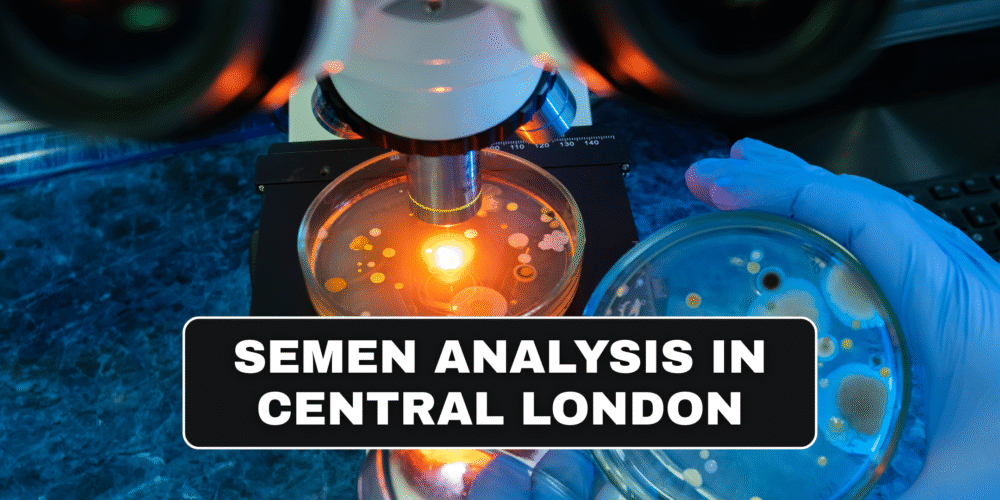
Understanding Sperm Analysis: A Comprehensive Guide
Marylebone Diagnostic Centre
73 Baker Street
For many couples, the journey to parenthood doesn’t always go as smoothly as planned. When conception takes longer than expected, fertility testing can provide valuable insights. Among these tests, sperm analysis or semen analysis plays a crucial role. This comprehensive guide will walk you through the key aspects of sperm analysis to help you understand its importance and what to expect.
Sperm analysis is a test that evaluates the health and viability of a man’s sperm. It is often one of the first steps in fertility testing when a couple faces challenges in conceiving. The test measures several factors, including sperm count, motility, and morphology, to determine if there are any issues that might affect fertility.
Why is Sperm Analysis Important?
For couples struggling with infertility, understanding the male partner’s reproductive health is as vital as understanding the female’s. Sperm analysis can identify potential issues such as low sperm count or poor motility, which can contribute to difficulties in conceiving. By identifying these problems early, couples can explore appropriate treatments or interventions to improve their chances of conception.
The Sperm Analysis Process
The process of sperm analysis is straightforward and typically requires a sample of semen. Here’s a step-by-step overview of what you can expect.
Sample Collection
The first step in a sperm analysis is collecting a semen sample. This is usually done through masturbation into a sterile container at a clinic. In some cases, it might be possible to collect the sample at home, provided it is delivered to the laboratory within a specified time frame. It’s important to follow any pre-test instructions, such as abstaining from ejaculation for two to five days before the test, to ensure accurate results.
Laboratory Analysis
Once the sample is collected, it is sent to a laboratory for analysis. Technicians will evaluate several parameters of the sperm, including:
- Sperm Count: The number of sperm present in a given volume of semen. A normal sperm count is typically considered to be 15 million sperm per milliliter or more.
- Motility: The ability of sperm to move efficiently. Motility is crucial for sperm to travel through the female reproductive tract to reach and fertilize an egg.
- Morphology: The shape and structure of the sperm. Abnormal sperm morphology can affect the sperm’s ability to fertilize an egg.
Understanding the Results
The results of a sperm analysis can provide a wealth of information about male fertility. Here’s what the key parameters mean:
- Normal Results: A normal sperm analysis will show a healthy sperm count, good motility, and a normal shape of sperm. This indicates that the male partner’s fertility is likely not an issue.
- Abnormal Results: If the sperm count is low, motility is poor, or morphology is abnormal, it may suggest a fertility issue. However, a single abnormal result doesn’t necessarily mean there is a permanent problem; further testing or repeat analysis might be needed.
Common Causes of Abnormal Sperm Analysis
Lifestyle Factors
Lifestyle choices can significantly impact sperm health. Smoking, excessive alcohol consumption, drug use, and obesity are known to negatively affect sperm quality. Making healthier lifestyle choices can improve sperm parameters and overall fertility.
Medical Conditions
Certain medical conditions can also lead to abnormal sperm analysis results. These include:
- Hormonal Imbalances: Conditions affecting hormone levels, such as low testosterone, can impact sperm production.
- Genetic Factors: Genetic abnormalities or chromosomal defects can contribute to male infertility.
- Infections or Inflammation: Infections of the reproductive tract, such as epididymitis or prostatitis, can affect sperm health.
What to Do After an Abnormal Sperm Analysis
If your sperm analysis results are abnormal, it’s important to consult with a healthcare professional to determine the next steps. They may recommend further testing to pinpoint the cause of the abnormalities or suggest lifestyle changes or treatments to improve sperm health.
Treatment Options
Depending on the underlying cause of the abnormal sperm analysis, various treatment options may be available:
- Medication: Hormonal treatments or medications to treat infections may be prescribed.
- Lifestyle Changes: Adopting a healthier lifestyle by quitting smoking, reducing alcohol consumption, and maintaining a healthy weight can improve sperm quality.
- Assisted Reproductive Technologies (ART): In cases where natural conception is difficult, techniques such as in vitro fertilization (IVF) or intracytoplasmic sperm injection (ICSI) may be considered.
Sperm analysis is a vital tool in assessing male fertility and identifying potential issues that could impact a couple’s ability to conceive. By understanding what sperm analysis involves and what the results mean, you can take informed steps toward addressing any fertility challenges you may face. If you have concerns about your fertility or sperm analysis results, consult with a healthcare provider to explore your options and develop a plan tailored to your needs.
If you need further information or cost details on sperm analysis, please get in touch discreetly:
Marylebone Diagnostic Centre
73 Baker Street, London
+44 7495 970109 – WhatsApp
marylebonediagnosticcentre.com











